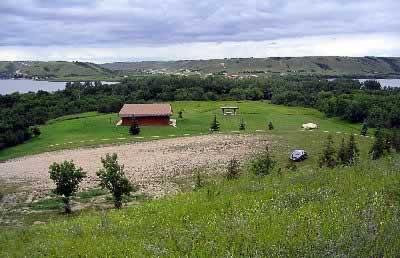
 |
|
Qu'Appelle Valley Geolog Stop 1
- Park Nature Centre
[ Next Stop ] The original Geolog Tour began at the Echo Lake Provincial Park Visitor Centre, found in the camping area on the Pasqua Lake side of Route 210. The Visitor Centre is used by park staff in the summer months to encourage tourists to learn more about Saskatchewan and the Qu'Appelle area. Currently Stop 1 is an open field of mowed grass, and has few visible native species of plants. However, the hill behind Stop is another story. Here almost every plant species identified in this project was visible. What is interesting about Stop 1 are the numerous erratic boulders found around the site. The two largest are found in the open field surrounding the Visitor Centre building. Boulders The two erratic boulders were carried to the Qu'Appelle Valley by glaciers moving from the Manitoba Lowlands - a distance of over 322km. The first boulder, to the north of the Visitor Centre, has grooves cut into it by abrasive rock fragments embedded in the bottom of a moving glacier. Geologists estimate this boulder was plucked by a glacier during the Ordovician period in Manitoba, about 500 - 430 million years ago. The second boulder is found east of the Visitor Centre. Geologists estimate that both boulders were eroded by the same glacier at the same time, but this boulder has many more unique features than the first. The east side of this boulder is gently inclined and smoothly rounded but striated. The west side of this boulder is steep, rough and jagged. These features show that the boulder was cut by the rubbing of rock fragments embedded in the base of a moving glacier as it moved over the boulder. The surface of the boulder shows crescentic gouges, which indicate that the direction of the ice movement was from the North - Northwest. Both boulders were discovered when excavation for building the Visitor Centre began. They were taken from the ground, examined by geologists, and placed in their current positions by park staff. Hiking Trails The Hiking Trail beside the Stop was discovered almost by accident - there are no signs; nothing to indicate its existence except for a patch of mowed grass leading to it. Along the trail are more erratic boulders, Canada anemones, Rhubarb, Wild sarsaparilla, Trembling aspens, Manitoba maples, Balsam poplars, grasses, Red-osier dogwood, Wood's roses, Prickly roses, a squirrel, and a nest of what may be baby woodpeckers, who can be heard here using Quicktime or here using Windows Media Player. View a slideshow of the nature trail here. Another trail to check out is the Interpretive Nature Trail by the Hole-in-Wall Campground near the Nature Centre. This trail begins in a deciduous forest, leading up a hill to open prairie and returns back into forest to complete the trail. This trail demonstrates the transitions of vegetation composition through different communities based on soil type and moisture content, degree of slope and degree of shade. Due to the varying communities on this trail, there will be greater variabilty in the plant species that will be seen. View a slideshow of this trail here. Aerial Photo Click here to see an aerial photograph of stop 1.

Plant species found at stop 1:
|
Page last updated on
2004-10-08 |